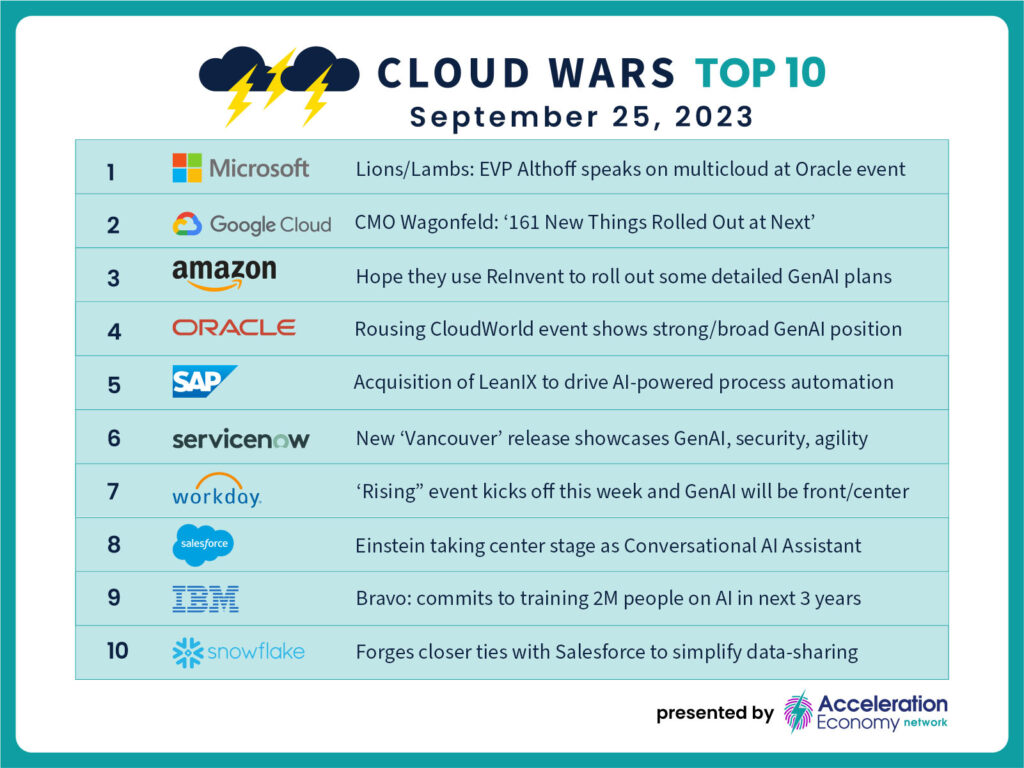
While some Cloud Wars Top 10 companies are rolling out premium-pricing strategies for their new generative AI (GenAI) portfolios, Oracle’s top four product executives vowed last week that they would not raise prices for GenAI features.
The contrast highlights the astonishing impact GenAI is having across the globe as these Cloud Wars Top 10 companies decide how to take these world-shaping new technologies to market.
As Oracle chairman Larry Ellison said in his keynote at Oracle CloudWorld last week, “Most new tech does not get the attention of CEOs, heads of state, heads of government, but that’s exactly what’s happened with Generative AI.”
At CloudWorld, a Q&A session was held with executive vice-presidents Clay Magouyrk, who leads cloud infrastructure; Steve Miranda, the longtime head of applications; Mike Sicilia, who runs Oracle Industries; and Juan Loaiza, head of mission-critical database technologies.
My question to the group was basically this: Some of Oracle’s major cloud competitors have said they intend to raise prices for cloud services featuring new GenAI capabilities. In light of that, what is Oracle’s policy on pricing for services incorporating GenAI features?
Before I get to the replies from the Oracle execs, I’ll note the following moves by some other cloud vendors that formed the basis of my question:
- “Salesforce Price Hikes Are Blood in the Water for Oracle and SAP” (July 20);
- “SAP Will Charge 30% Premium for Full Cloud-Only AI Portfolio” (July 24; and
- “ServiceNow’s Big Q2: ‘Supercharged by Generative AI'” (Aug. 1).
My position on those moves has been consistent: If business customers perceive that the new GenAI-powered offerings warrant a price increase, then that’s a big win for both the buyers and the sellers. I’m an uncompromising believer in the idea that creators should charge what the market will bear — because that puts the full leverage in the hands of the customers. If customers see the value, they’ll pay; if they don’t, they’ll take their business elsewhere, and the seller can either hold the line and hope that others will meet the seller’s price, or reduce prices to align with what buyers are willing to pay.
With that backdrop, here’s how the four Oracle executive VPs replied to my question.
OCI chief Magouyrk: “As far as Oracle infrastructure goes, there’ll be no change” in pricing.
Applications chief Miranda: “That’s just a silly viewpoint…. When self-service HR was created, did they want to charge extra for that?” Miranda emphasized that a single instance of Fusion Cloud applications means that all customers will get the new GenAI capabilities, and he scoffed at the notion that Oracle would ever consider offering “old ERP and also AI ERP.”
Industries chief Sicilia: “We’re embedding it into all of our industry apps — no pricing change.”
Mission-critical database tech chief Loaiza: “Geez, I think 25 years ago when we added some AI stuff into the Oracle Database, we might have changed the price for that. But now, we’re making all of these new AI features free with the database — that’s just the new normal.”
Final Thought
In the sharp contrast we see among the pricing policies of these four superb companies, we see yet again the power of free-market capitalism and robust competition that results in broad and deep choices and alternatives for customers. It might turn out that each of these four companies finds huge success with its new GenAI plan — after all, different customers have different needs and different expectations.
We also need to bear in mind that in spite of the truly world-changing impact that GenAI has had and is having and will surely continue to have, it has only been out in public for 10 months — just 300 days!
That’s a very short time in which to gauge long-term value, and I’m not surprised to see that different approaches have arisen about how to charge for that value.
And I suspect this is just the first chapter in what will surely be a long story.

Gain insight into the way Bob Evans builds and updates the Cloud Wars Top 10 ranking, as well as how C-suite executives use the list to inform strategic cloud purchase decisions. That’s available exclusively through the Acceleration Economy Cloud Wars Top 10 Course.









